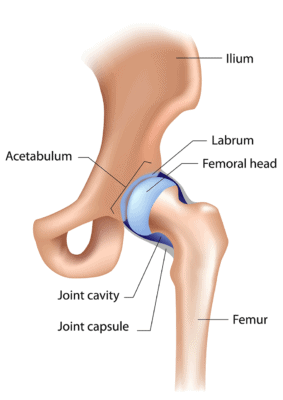Labrum Tear on Your MRI? It May Not Be Related to Your Hip Pain
Orthopedic surgeons have created yet another mass hysteria in patients over this issue of hip labrum tears. I have spoken with hundreds of patients over the last 5–10 years who are absolutely terrified about a small tear on an MRI image observed by a radiologist after they developed hip pain. While surgery is often recommended, what if that tear had nothing to do with why the hip hurts and was merely an innocent bystander?
Hip Pain and Hip Labrum Tears: Why Surgery Isn’t the Answer

Alila Medical Media/Shutterstock
The hip is a ball-and-socket joint, and the labrum forms a lip around the socket part of the hip joint and helps stabilize the structure. The labrum, just like the meniscus in the knee, can become torn, typically due to wear and tear, particularly as we age.
As radiology imaging systems have become more and more advanced, these technologies are detecting things, such as labrum tears, that radiologists would have never seen a decade ago. In most cases, this is a very good thing, but it can be frightening when we see words such as “tear” on our radiology report. So when surgeons suggest “repairing” these hip labrum tears, many patients are more than happy to agree. However, just like with meniscus tears, study after study has found the labrum tears seen on MRI aren’t a cause of hip pain. So it seems we should be finding the cause of the pain, not, in most cases, performing labrum surgery.
The First Mass Hysteria: Knee Meniscus Tears
Likely the biggest medical scam of the twentieth century was operating on meniscus tears in patients over 35 years of age. Why? Because we now have many high-level studies showing that people without knee pain in this age group are just as likely to have a meniscus tear as those with knee pain. Meaning, the presence or absence of a meniscus tear in a middle-aged or older person is a flip of a coin that is not related to why the knee hurts. In addition, multiple research studies have shown that operating on knee meniscus tears does no good, regardless of the clinical situation. Despite all of this, I still see patients every day who are convinced that their meniscus tear on their MRI is smoking gun-type evidence of why their knee hurts, when in fact, it’s as important as the wrinkles around their eyes.
Hip Labrum Tears Seen on MRI May Not Be the Cause of Hip Pain
The new study was a meta-analysis, meaning pooling together the data from separate but similar studies (29 in this case). Researchers were specifically investigating the relationship between what is seen on hip MRIs and hip pain. One of those conditions was hip labrum tears, and the results weren’t a surprise to me but will be for many patients. For those with hip pain, there was limited radiological evidence that 62% had labral tears. While this seems high, for those without hip pain, there was stronger radiological evidence that 54% had labral tears. The difference between these groups wasn’t significant.
What does this mean? It means labral tears can exist whether there is hip pain or not. It means in patients who do have hip pain, we can’t assume that labral tears seen on MRI are the cause of the pain. Yet, unfortunately, many times that is exactly what happens.
If My Labrum Tear Isn’t Causing My Hip Pain, What Is?
Believe it or not, many conditions that have nothing to do with the hip can cause hip pain. These include problems with the sacroiliac (SI) joint, or hip girdle muscles, ligaments, or tendons or even pinched nerves in the low back as the nerves that branch from the lumbosacral spine supply the hips and lower limbs. Let’s explore a few potential causes of hip pain a bit more.
Sacroiliac Joint Instability
The SI joints (three total) live at the back of the hip, where the hip meets the sacrum (tailbone). Their job is to help distribute forces from the leg to the spine, and the joint relies on the strong ligaments around it for support. SI joint instability occurs when the ligaments are damaged. In addition to hip pain, with SI joint instability your leg might feel wobbly or a bit disconnected.
Low Back Conditions
The hip and the entire lower extremities are supplied by nerves that branch off of the spinal column in the lower back. Any number of issues in the lower spine that affect those nerve branches can cause pain and functional problems at any location stretching from the hips all the way down to the toes. These could include herniated or bulging discs, arthritis, degenerated discs, spinal stenosis, and so on.
The upshot? So while an MRI may show that you have a hip labrum tear and you may have hip pain, it’s more likely the labral tear is just an incidental finding of wear and tear normal with aging, not a sole indicator for surgery. And if your hip pain is actually due to SI joint instability, a stretched ligament, a nerve issue in the lower back, or something else, surgery to repair a torn labrum is counterproductive and certainly isn’t going to fix your hip pain.

If you have questions or comments about this blog post, please email us at [email protected]
NOTE: This blog post provides general information to help the reader better understand regenerative medicine, musculoskeletal health, and related subjects. All content provided in this blog, website, or any linked materials, including text, graphics, images, patient profiles, outcomes, and information, are not intended and should not be considered or used as a substitute for medical advice, diagnosis, or treatment. Please always consult with a professional and certified healthcare provider to discuss if a treatment is right for you.